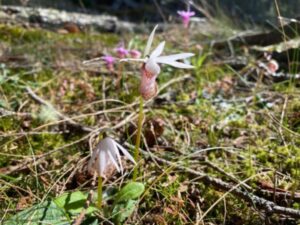— Amanda Wedow, Lopez Island Preserve Steward
As spring starts to unfold, you may be fortunate to spot this cheery native orchid on a mossy or needle-strewn forest floor. The plant genus Calypso is from Greek mythology and means hidden from view so you will have to look with a careful eye!
The Calypso orchid has singular plant parts – one underground corm, one leaf, and one flower. The leaf emerges in fall and persists through the winter. In spring, a slender stem supports a delicate rosy-colored flower. The unique shape of the flower inspires the plant’s common name of Fairy-slipper.

The flower is showy, and characteristic of orchids has several modified parts. The “slipper” is a modified petal called a lip. It is spotted outside and streaked inside and is a landing platform for pollinators such as bumblebees. The five upright narrow “petals” are three sepals and two petals alike in color and shape.
Calypso bulbosa is truly a wild flower. It forms a close association with mycorrhizal fungi, and this relationship makes these wild plants very difficult to transplant or propagate. Soil mycorrhizae extend the short root structure and support germination of the tiny seeds.
The entire plant is also extremely fragile. Picking or trampling can cause fatal damage. Fairy-slippers are best left in place and enjoyed from the trail. 
Hitchcock, C.L. and A. Cronquist. (1976). Flora of the Pacific Northwest. Seattle, WA, University of Washington Press.
Pojar, J. and A. Mackinnon. (1994). Plants of the Pacific Northwest Coast. BC, Lone Pine Publishing.

